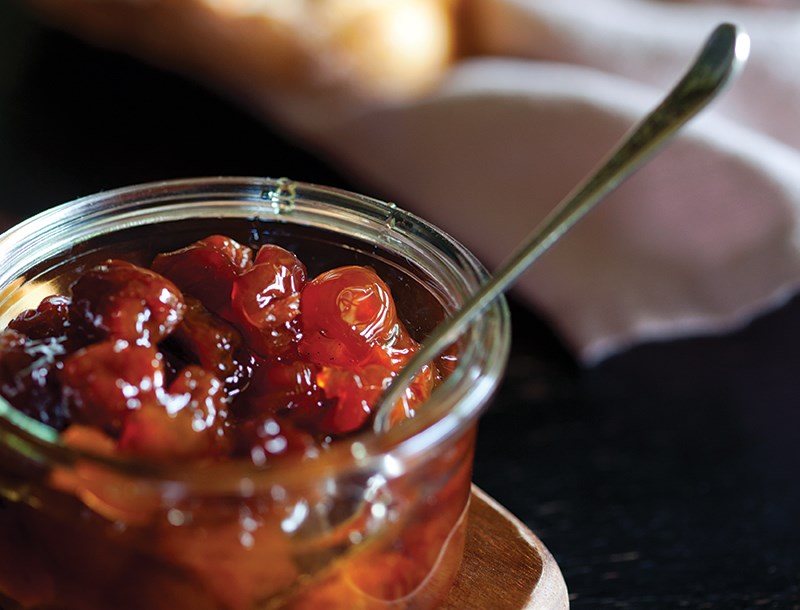Right now our gardens and markets are bursting with seasonal produce that we just can’t wait to transform into cocktails. But don’t you wish you could enjoy those garden-fresh flavours year round?
Well, you can, with a little help from Lee Murphy.
Murphy is the proprietor of Vista d’Oro Farms and Winery, and the author of the recently published cookbook The Preservatory: Seasonally inspired recipes for creating and cooking with artisanal preserves (Appetite by Random House).
You’ve probably seen her gorgeous preserves in gourmet markets: Craft Beer Jam, Figs & Walnut Wine, Pink Grapefruit with Champagne, Blueberry & Bourbon, Blood Orange with Campari & Vanilla Bean. And you may have noticed that Murphy has a flair for adding a splash of booze to her jams – and, as it turns out, a touch of jam to her booze.
“I do like a good cocktail,” she admits with a laugh. In fact, she has said she always wanted to produce a full cocktail line of preserves, which sounds like a pretty good idea when you think about it.
In the meantime, we can follow her tips for getting all that fresh bounty into a glass.
Right now, the easiest thing to do is to take fresh herbs and simply muddle them into cocktails, the way you do with mint in a Mojito.
For instance, cilantro is delicious in a Margarita, while lemon verbena adds a floral essence to a Lemon Drop martini and mint works wonders in a myriad of cocktails from juleps to Mai Tais to Collinses.
Or you can make herbs into syrups.
Start by making a simple syrup by bringing equal amounts of sugar and water to a boil, then steep the herbs in the hot syrup as you would tea. You’ll want to steep them longer for woody herbs like rosemary and thyme, and less for soft ones like basil and mint. Store them in sterilized containers and they’ll keep for a couple of weeks in the fridge.
Aside from herbs, our markets are ripe with fresh local fruit.
“Every berry is good in a cocktail,” Murphy says. Strawberries, raspberries, blueberries and blackberries all work beautifully in cocktails. So do tree fruits like cherries, peaches and, later in the season, plums, apples and pears.
You can juice them, purée them, turn them into shrubs (also known as “drinking vinegars”) or make them into preserves such as jam, jelly or marmalade.
Murphy loves using preserves in cocktails and her book is full of suggestions for doing just that, such as her “Jamargarita” made with Smoked Lime Margarita preserves.
“We use them the same way we use simple syrup. Just use a little less,” she suggests.
You can also pickle produce, especially vegetables, for great garnishes.
“You can do any kind of pickle,” Murphy says. “You can make quick pickles, too. Just pour the brine over it and keep it in the fridge.”
Pickled radishes, carrots, beans and asparagus are ideal for savoury drinks like Caesars and Bloody Marys, while cherries pickled in sweet brine add a piquant touch to a Manhattan.
In fact, this is the time to make the most of our short but sweet cherry season. One way to do that is with Murphy’s recipe for cherries in kirsch (see below) – it’ll let you enjoy their summery flavour for months to come.
“They would be good in a Manhattan or Old Fashioned, or a Negroni, my favourite cocktail,” Murphy says.
We’ll drink to that.
Rainier Cherry & Kirsch
Use these preserved cherries to garnish a wide range of cocktails, such as the Negroni. Recipe from The Preservatory by Lee Murphy (Appetite by Random House). Note that you will have to start this a day ahead.
Makes 8 to 10 8-oz (250 mL) jars
6 lbs (2.75 kg) whole Rainier or other sweet cherries
½ cup (125 mL) fresh lemon juice
1 vanilla bean
8 cups (2 L) granulated sugar
1/3 cup + 1 ½ tbsp (100 mL) kirsch
Stem and pit the cherries – you should have 5 lbs (2.25 kg) of prepared fruit.
Pour the lemon juice into a large, non-reactive bowl. Cut vanilla bean in half lengthwise and scrape out the seeds with the dull side of a paring knife. Stir vanilla seeds into lemon juice and whisk to separate seeds.
Add pitted cherries and sugar to vanilla-lemon juice and stir well. Cover and place in the fridge to macerate overnight.
The next day, fill your preserving pot with water and bring to a boil. Place 10 8-oz (250-mL) jars and their snap lids in the pot and sterilize for at least 15 minutes. Keep hot until you’re ready to fill the jars.
Strain cherries from their accumulated juices, reserving the cherries and pouring the juices into a separate stainless steel jam pot. Boil the juice until it reaches the setting point at 220°F (110°C).
Add the cherries and bring the mixture back to a boil, frequently skimming any foam that rises. Cook to set, again to 220°F (110°C).
Remove jars and snap lids from the preserving pot, but keep the water simmering.
Remove preserves from heat and carefully stir in kirsch. Let sit 5 minutes, then, using a slotted spoon, divide the cherries equally between the jars. (Note that you might only have enough for 8 jars – don’t overfill them.)
Pour the remaining cherry syrup over the cherries until the jars are filled ¼ inch (0.5 cm) from the top. Wipe the rims, place the snap lids on, and loosely screw on the ring bands.
Return jars to the pot of boiling water and process for 10 to 15 minutes. Remove and cool to room temperature. If you hear a “pop” and the dimple on top of the snap lid has turned concave, your preserves are good and you can keep them in a cool, dark place for up to six months. If not, place them in the refrigerator and consume within two weeks.



